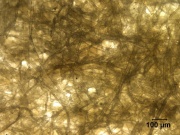Difference between revisions of "India paper"
m (Text replace - "== Authority ==" to "== Sources Checked for Data in Record ==") |
|||
| Line 25: | Line 25: | ||
| − | == | + | == Sources Checked for Data in Record == |
* Ralph Mayer, ''A Dictionary of Art Terms and Techniques'', Harper and Row Publishers, New York, 1969 (also 1945 printing) | * Ralph Mayer, ''A Dictionary of Art Terms and Techniques'', Harper and Row Publishers, New York, 1969 (also 1945 printing) | ||
Revision as of 05:36, 1 May 2016
Description
A very thin, opaque Paper. India paper was made in China and imported to Europe by the Dutch East India Company from about 1768 to 1875 when Oxford India, an imitation paper, was developed in England using processed rags and Hemp (Roberts and Etherington 1982). India paper is thin and has a basis weight of 20 pounds with approximately 1000 pages to an inch. It is used for printing thin paper editions such as bibles and reference books.
Synonyms and Related Terms
Bible paper; Oxford India paper; India proof; India transfer paper; China paper; encre de Chine (Fr.); encre à dessin (Fr.)
Additional Information
M.Roberts, D.Etherington, Bookbinding and the Conservation of Books: a Dictionary of Descriptive Terminology, U.S. Government Printing Office, Washington, DC, 1982.
Additional Images
Sources Checked for Data in Record
- Ralph Mayer, A Dictionary of Art Terms and Techniques, Harper and Row Publishers, New York, 1969 (also 1945 printing)
- Boise Cascade Paper Group, The Paper Handbook, Boise Cascade, Portland OR, 1989
- Matt Roberts, Don Etherington, Bookbinding and the Conservation of Books: a Dictionary of Descriptive Terminology, U.S. Government Printing Office, Washington DC, 1982
- Book and Paper Group, Paper Conservation Catalog, AIC, 1984, 1989
- Art and Architecture Thesaurus Online, http://www.getty.edu/research/tools/vocabulary/aat/, J. Paul Getty Trust, Los Angeles, 2000






